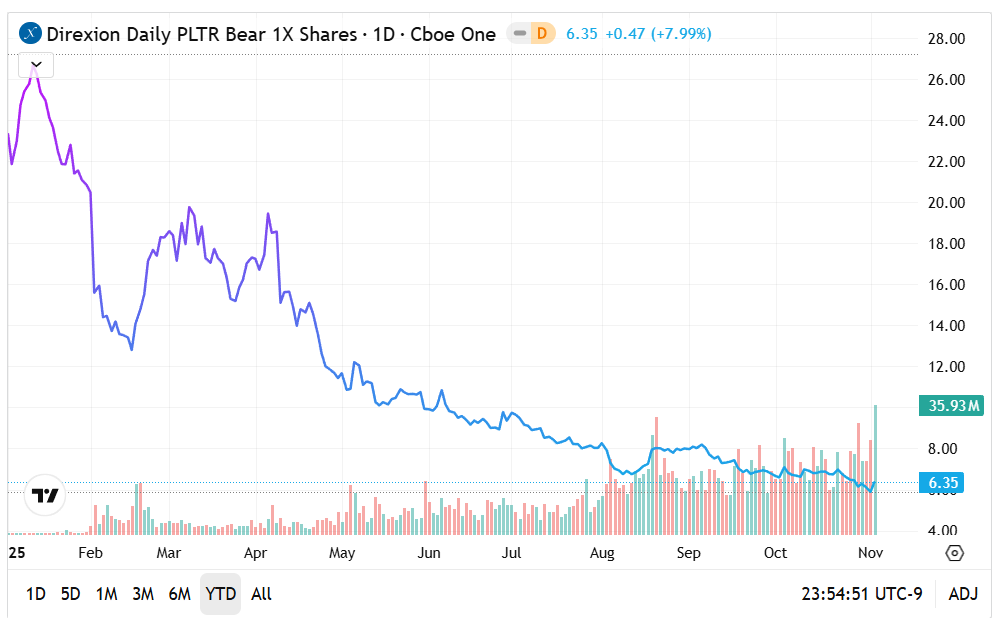
On paper, big data analytics giant Palantir Technologies Inc (NASDAQ:PLTR) still represents one of the strongest statistical performances among major publicly traded enterprises. Since the start of the year, PLTR stock has moved up over 152%. Nevertheless, the security saw a sudden drop recently. Furthermore, Tuesday's after-hours session implies further volatility may be lying in the wings, raising concerns among investors.
What makes the matter so discombobulating for market participants is that earlier, Palantir reported better-than-expected financial results for the third quarter. Following Monday's close, the tech specialist reported revenue of $1.18 billion, beating out Wall Street analysts' consensus target of $1.09 billion. Furthermore, the artificial-intelligence-enabled software company posted adjusted earnings of 21 cents per share, rising above calls for 17 cents per share.
If that wasn't enough, management also revealed expectations for fourth-quarter revenue to range between $1.327 billion and $1.331 billion. This distribution of expected outcomes exceeded the consensus view of $1.19 billion. Plus, Palantir raised its full-year guidance, disclosing anticipated revenue of $4.396 billion to $4.4 billion. This is up from prior guidance of $4.14 billion to $4.15 billion.
Notably, analysts were looking at full-year revenue to reach only $4.17 billion. So, with such strong results and robust confidence in forward guidance, what caused the downturn in PLTR stock?
According to analysts, it's possible that the equity simply accelerated too quickly over too short a time span. Goldman Sachs analyst Gabriela Borges believes that PLTR's muted reaction comes amid "high expectations" following several strong quarters. MacroVisor analyst Ayesha Tariq points the finger at shifting market conditions, with investors being pensive about richly valued tech stocks.
To be sure, valuation ratios don't represent universal truth claims, so they need to be taken with a grain of salt. However, from a strictly psychological perspective, it may be difficult for investors to ignore the raw numbers. For example, PLTR stock now trades for over 217 times forward earnings. It's also trading at over 137 times trailing-year sales.
Again, these figures need context, as there is no standard benchmark to absolutely determine whether a security is overvalued or not. Still, with such a significant jump in relative value, it's understandable that some investors are concerned about excessive risk exposure.
The Direxion ETFs: With market participants on both sides of the table eager to speculate, financial services provider Direxion offers a pair of relevant, countervailing products. For optimistic traders, the Direxion Daily PLTR Bull 2X Shares (NASDAQ:PLTU) tracks 200% of the daily performance of PLTR stock. For pessimists, the Direxion Daily PLTR Bear 1X Shares (NASDAQ:PLTD) tracks 100% of the inverse performance of the namesake security.
In both cases, the primary selling point is convenience. Usually, traders who are interested in leveraged or inverse positions must engage the options market. However, certain derivative or synthetic strategies carry complexities which may not align with every investor's interest. In contrast, Direxion ETFs are straightforward, debit-based transactions, functioning very much like any other publicly traded security.
Still, familiarity does not mean that there are no risks. For one thing, leveraged and inverse funds tend to be more volatile than standard vehicles tracking benchmark indices like the Nasdaq Composite. Second, Direxion ETFs carry nuanced risks, with illiquidity being a possible challenge. Finally, these funds are designed for exposure lasting no longer than one day. Going beyond this recommended period may expose investors to positional decay due to the daily compounding effect.
The PLTU ETF: Since the start of the year, the PLTU ETF has gained over 285%. In the trailing six months, the fund has swung up almost 94%.
- Presently, PLTU's price action is solid, standing above the 50 and 200-day moving averages. However, recent volatility has forced the ETF to sit atop its 20-day exponential moving average.
- One area of concern is the steady erosion of volume. Ordinarily, a rising price action should be confirmed by rising volume, which isn't happening here.

The PLTD ETF: From the January opener, the PLTD ETF has dropped almost 73%. In the trailing half-year period, the inverse fund has dipped nearly 42%.
- In contrast to the bull fund, PLTD's price action sits firmly below the 50 and 200 DMAs. It has risen against the 20-day EMA in recent sessions, though.
- What's intriguing here is volume. As a picture of contrast to PLTU, the PLTD ETF has witnessed a conspicuous rise in capital inflows.

Featured image from Shutterstock







